
- •Contents
- •Send Us Your Comments
- •Preface
- •What’s New in SQL Reference?
- •1 Introduction to Oracle SQL
- •History of SQL
- •SQL Standards
- •Embedded SQL
- •Lexical Conventions
- •Tools Support
- •2 Basic Elements of Oracle SQL
- •Datatypes
- •Oracle Built-in Datatypes
- •ANSI, DB2, and SQL/DS Datatypes
- •Oracle-Supplied Types
- •"Any" Types
- •XML Types
- •Spatial Type
- •Media Types
- •Datatype Comparison Rules
- •Data Conversion
- •Literals
- •Text Literals
- •Integer Literals
- •Number Literals
- •Interval Literals
- •Format Models
- •Number Format Models
- •Date Format Models
- •String-to-Date Conversion Rules
- •XML Format Model
- •Nulls
- •Nulls in SQL Functions
- •Nulls with Comparison Conditions
- •Nulls in Conditions
- •Pseudocolumns
- •CURRVAL and NEXTVAL
- •LEVEL
- •ROWID
- •ROWNUM
- •XMLDATA
- •Comments
- •Comments Within SQL Statements
- •Comments on Schema Objects
- •Hints
- •Database Objects
- •Schema Objects
- •Nonschema Objects
- •Parts of Schema Objects
- •Schema Object Names and Qualifiers
- •Schema Object Naming Rules
- •Schema Object Naming Examples
- •Schema Object Naming Guidelines
- •Syntax for Schema Objects and Parts in SQL Statements
- •How Oracle Resolves Schema Object References
- •Referring to Objects in Other Schemas
- •Referring to Objects in Remote Databases
- •Referencing Object Type Attributes and Methods
- •3 Operators
- •About SQL Operators
- •Unary and Binary Operators
- •Operator Precedence
- •Arithmetic Operators
- •Concatenation Operator
- •Set Operators
- •4 Expressions
- •About SQL Expressions
- •Simple Expressions
- •Compound Expressions
- •CASE Expressions
- •CURSOR Expressions
- •Datetime Expressions
- •Function Expressions
- •INTERVAL Expressions
- •Object Access Expressions
- •Scalar Subquery Expressions
- •Type Constructor Expressions
- •Variable Expressions
- •Expression Lists
- •5 Conditions
- •About SQL Conditions
- •Condition Precedence
- •Comparison Conditions
- •Simple Comparison Conditions
- •Group Comparison Conditions
- •Logical Conditions
- •Membership Conditions
- •Range Conditions
- •Null Conditions
- •EQUALS_PATH
- •EXISTS Conditions
- •LIKE Conditions
- •IS OF type Conditions
- •UNDER_PATH
- •Compound Conditions
- •6 Functions
- •SQL Functions
- •Single-Row Functions
- •Aggregate Functions
- •Analytic Functions
- •Object Reference Functions
- •Alphabetical Listing of SQL Functions
- •ACOS
- •ADD_MONTHS
- •ASCII
- •ASCIISTR
- •ASIN
- •ATAN
- •ATAN2
- •BFILENAME
- •BITAND
- •CAST
- •CEIL
- •CHARTOROWID
- •COALESCE
- •COMPOSE
- •CONCAT
- •CONVERT
- •CORR
- •COSH
- •COUNT
- •COVAR_POP
- •COVAR_SAMP
- •CUME_DIST
- •CURRENT_DATE
- •CURRENT_TIMESTAMP
- •DBTIMEZONE
- •DECODE
- •DECOMPOSE
- •DENSE_RANK
- •DEPTH
- •DEREF
- •DUMP
- •EMPTY_BLOB, EMPTY_CLOB
- •EXISTSNODE
- •EXTRACT (datetime)
- •EXTRACT (XML)
- •EXTRACTVALUE
- •FIRST
- •FIRST_VALUE
- •FLOOR
- •FROM_TZ
- •GREATEST
- •GROUP_ID
- •GROUPING
- •GROUPING_ID
- •HEXTORAW
- •INITCAP
- •INSTR
- •LAST
- •LAST_DAY
- •LAST_VALUE
- •LEAD
- •LEAST
- •LENGTH
- •LOCALTIMESTAMP
- •LOWER
- •LPAD
- •LTRIM
- •MAKE_REF
- •MONTHS_BETWEEN
- •NCHR
- •NEW_TIME
- •NEXT_DAY
- •NLS_CHARSET_DECL_LEN
- •NLS_CHARSET_ID
- •NLS_CHARSET_NAME
- •NLS_INITCAP
- •NLS_LOWER
- •NLSSORT
- •NLS_UPPER
- •NTILE
- •NULLIF
- •NUMTODSINTERVAL
- •NUMTOYMINTERVAL
- •PATH
- •PERCENT_RANK
- •PERCENTILE_CONT
- •PERCENTILE_DISC
- •POWER
- •RANK
- •RATIO_TO_REPORT
- •RAWTOHEX
- •RAWTONHEX
- •REFTOHEX
- •REGR_ (Linear Regression) Functions
- •REPLACE
- •ROUND (number)
- •ROUND (date)
- •ROW_NUMBER
- •ROWIDTOCHAR
- •ROWIDTONCHAR
- •RPAD
- •RTRIM
- •SESSIONTIMEZONE
- •SIGN
- •SINH
- •SOUNDEX
- •SQRT
- •STDDEV
- •STDDEV_POP
- •STDDEV_SAMP
- •SUBSTR
- •SYS_CONNECT_BY_PATH
- •SYS_CONTEXT
- •SYS_DBURIGEN
- •SYS_EXTRACT_UTC
- •SYS_GUID
- •SYS_TYPEID
- •SYS_XMLAGG
- •SYS_XMLGEN
- •SYSDATE
- •SYSTIMESTAMP
- •TANH
- •TO_CHAR (character)
- •TO_CHAR (datetime)
- •TO_CHAR (number)
- •TO_CLOB
- •TO_DATE
- •TO_DSINTERVAL
- •TO_MULTI_BYTE
- •TO_NCHAR (character)
- •TO_NCHAR (datetime)
- •TO_NCHAR (number)
- •TO_NCLOB
- •TO_NUMBER
- •TO_SINGLE_BYTE
- •TO_TIMESTAMP
- •TO_TIMESTAMP_TZ
- •TO_YMINTERVAL
- •TRANSLATE
- •TRANSLATE ... USING
- •TREAT
- •TRIM
- •TRUNC (number)
- •TRUNC (date)
- •TZ_OFFSET
- •UNISTR
- •UPDATEXML
- •UPPER
- •USER
- •USERENV
- •VALUE
- •VAR_SAMP
- •VARIANCE
- •VSIZE
- •WIDTH_BUCKET
- •XMLAGG
- •XMLCOLATTVAL
- •XMLCONCAT
- •XMLELEMENT
- •XMLFOREST
- •XMLSEQUENCE
- •XMLTRANSFORM
- •ROUND and TRUNC Date Functions
- •User-Defined Functions
- •Prerequisites
- •Name Precedence
- •7 Common SQL DDL Clauses
- •allocate_extent_clause
- •constraints
- •deallocate_unused_clause
- •file_specification
- •logging_clause
- •parallel_clause
- •physical_attributes_clause
- •storage_clause
- •8 SQL Queries and Subqueries
- •About Queries and Subqueries
- •Creating Simple Queries
- •Hierarchical Queries
- •The UNION [ALL], INTERSECT, MINUS Operators
- •Sorting Query Results
- •Joins
- •Using Subqueries
- •Unnesting of Nested Subqueries
- •Selecting from the DUAL Table
- •Distributed Queries
- •9 SQL Statements: ALTER CLUSTER to ALTER SEQUENCE
- •Types of SQL Statements
- •Organization of SQL Statements
- •ALTER CLUSTER
- •ALTER DATABASE
- •ALTER DIMENSION
- •ALTER FUNCTION
- •ALTER INDEX
- •ALTER INDEXTYPE
- •ALTER JAVA
- •ALTER MATERIALIZED VIEW
- •ALTER MATERIALIZED VIEW LOG
- •ALTER OPERATOR
- •ALTER OUTLINE
- •ALTER PACKAGE
- •ALTER PROCEDURE
- •ALTER PROFILE
- •ALTER RESOURCE COST
- •ALTER ROLE
- •ALTER ROLLBACK SEGMENT
- •ALTER SEQUENCE
- •10 SQL Statements: ALTER SESSION to ALTER SYSTEM
- •ALTER SESSION
- •ALTER SYSTEM
- •ALTER TABLE
- •ALTER TABLESPACE
- •ALTER TRIGGER
- •ALTER TYPE
- •ALTER USER
- •ALTER VIEW
- •ANALYZE
- •ASSOCIATE STATISTICS
- •AUDIT
- •CALL
- •COMMENT
- •COMMIT
- •13 SQL Statements: CREATE CLUSTER to CREATE JAVA
- •CREATE CLUSTER
- •CREATE CONTEXT
- •CREATE CONTROLFILE
- •CREATE DATABASE
- •CREATE DATABASE LINK
- •CREATE DIMENSION
- •CREATE DIRECTORY
- •CREATE FUNCTION
- •CREATE INDEX
- •CREATE INDEXTYPE
- •CREATE JAVA
- •14 SQL Statements: CREATE LIBRARY to CREATE SPFILE
- •CREATE LIBRARY
- •CREATE MATERIALIZED VIEW
- •CREATE MATERIALIZED VIEW LOG
- •CREATE OPERATOR
- •CREATE OUTLINE
- •CREATE PACKAGE
- •CREATE PACKAGE BODY
- •CREATE PFILE
- •CREATE PROCEDURE
- •CREATE PROFILE
- •CREATE ROLE
- •CREATE ROLLBACK SEGMENT
- •CREATE SCHEMA
- •CREATE SEQUENCE
- •CREATE SPFILE
- •15 SQL Statements: CREATE SYNONYM to CREATE TRIGGER
- •CREATE SYNONYM
- •CREATE TABLE
- •CREATE TABLESPACE
- •CREATE TEMPORARY TABLESPACE
- •CREATE TRIGGER
- •CREATE TYPE
- •CREATE TYPE BODY
- •CREATE USER
- •CREATE VIEW
- •DELETE
- •DISASSOCIATE STATISTICS
- •DROP CLUSTER
- •DROP CONTEXT
- •DROP DATABASE LINK
- •DROP DIMENSION
- •DROP DIRECTORY
- •DROP FUNCTION
- •DROP INDEX
- •DROP INDEXTYPE
- •DROP JAVA
- •DROP LIBRARY
- •DROP MATERIALIZED VIEW
- •DROP MATERIALIZED VIEW LOG
- •DROP OPERATOR
- •DROP OUTLINE
- •DROP PACKAGE
- •DROP PROCEDURE
- •DROP PROFILE
- •DROP ROLE
- •DROP ROLLBACK SEGMENT
- •17 SQL Statements: DROP SEQUENCE to ROLLBACK
- •DROP SEQUENCE
- •DROP SYNONYM
- •DROP TABLE
- •DROP TABLESPACE
- •DROP TRIGGER
- •DROP TYPE
- •DROP TYPE BODY
- •DROP USER
- •DROP VIEW
- •EXPLAIN PLAN
- •GRANT
- •INSERT
- •LOCK TABLE
- •MERGE
- •NOAUDIT
- •RENAME
- •REVOKE
- •ROLLBACK
- •18 SQL Statements: SAVEPOINT to UPDATE
- •SAVEPOINT
- •SELECT
- •SET CONSTRAINT[S]
- •SET ROLE
- •SET TRANSACTION
- •TRUNCATE
- •UPDATE
- •Required Keywords and Parameters
- •Optional Keywords and Parameters
- •Syntax Loops
- •Multipart Diagrams
- •Database Objects
- •ANSI Standards
- •ISO Standards
- •Oracle Compliance
- •FIPS Compliance
- •Oracle Extensions to Standard SQL
- •Character Set Support
- •Using Extensible Indexing
- •Using XML in SQL Statements
- •Index

ALTER MATERIALIZED VIEW
ALTER MATERIALIZED VIEW
Purpose
A materialized view is a database object that contains the results of a query. The FROM clause of the query can name tables, views, and other materialized views. Collectively these are called master tables (a replication term) or detail tables (a data warehouse term). This reference uses "master tables" for consistency. The databases containing the master tables are called the master databases.
Use the ALTER MATERIALIZED VIEW statement to modify an existing materialized view in one or more of the following ways:
■
■
■
■
To change its storage characteristics
To change its refresh method, mode, or time
To alter its structure so that it is a different type of materialized view
To enable or disable query rewrite.
Note: The keyword SNAPSHOT is supported in place of MATERIALIZED VIEW for backward compatibility.
See Also:
■CREATE MATERIALIZED VIEW on page 14-5 for more information on creating materialized views
■Oracle9i Advanced Replication for information on materialized views in a replication environment
■Oracle9i Data Warehousing Guide for information on materialized views in a data warehousing environment
Prerequisites
The privileges required to alter a materialized view should be granted directly, as follows:
The materialized view must be in your own schema, or you must have the ALTER ANY MATERIALIZED VIEW system privilege.
To enable a materialized view for query rewrite:
9-90 Oracle9i SQL Reference

ALTER MATERIALIZED VIEW
■If all of the master tables in the materialized view are in your schema, you must have the QUERY REWRITE privilege.
■If any of the master tables are in another schema, you must have the GLOBAL QUERY REWRITE privilege.
■If the materialized view is in another user’s schema, both you and the owner of that schema must have the appropriate QUERY REWRITE privilege, as described in the preceding two items. In addition, the owner of the materialized view must have SELECT access to any master tables that the materialized view owner does not own.
See Also: Oracle9i Advanced Replication and Oracle9i Data
Warehousing Guide
SQL Statements: ALTER CLUSTER to ALTER SEQUENCE 9-91
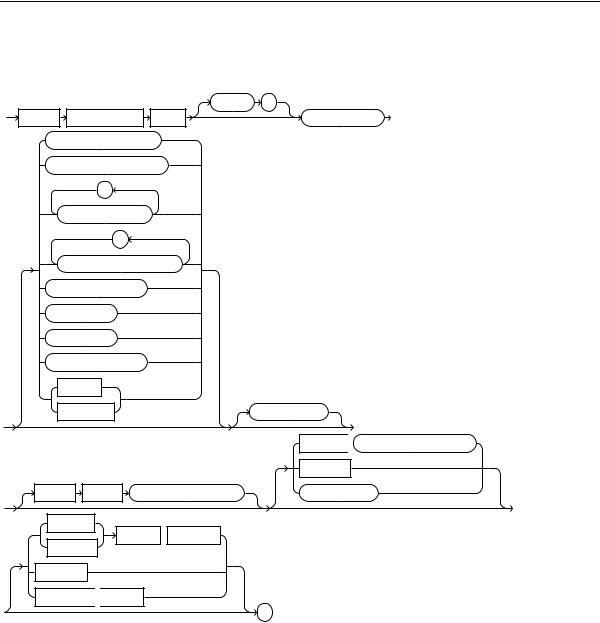
ALTER MATERIALIZED VIEW
Syntax
alter_materialized_view::=
|
|
schema |
. |
ALTER |
MATERIALIZED |
VIEW |
materialized_view |
physical_attributes_clause |
|
|
|
data_segment_compression |
|
||
|
, |
|
|
|
LOB_storage_clause |
|
|
|
, |
|
|
|
modify_LOB_storage_clause |
|
|
alter_table_partitioning |
|
|
|
parallel_clause |
|
|
|
logging_clause |
|
|
|
allocate_extent_clause |
|
|
|
|
CACHE |
|
|
|
NOCACHE |
|
alter_iot_clauses |
MODIFY  scoped_table_ref_constraint
scoped_table_ref_constraint
REBUILD
USING |
INDEX |
physical_attributes_clause |
alter_mv_refresh |
ENABLE
QUERY  REWRITE
REWRITE
DISABLE
COMPILE
CONSIDER  FRESH
FRESH
;
(physical_attributes_clause::= on page 9-93, data_segment_ compression::= on page 9-93, LOB_storage_clause::= on page 9-93, modify_LOB_storage_clause::= on page 9-94, alter_table_ partitioning on page 11-60 — part of ALTER TABLE syntax, parallel_
9-92 Oracle9i SQL Reference
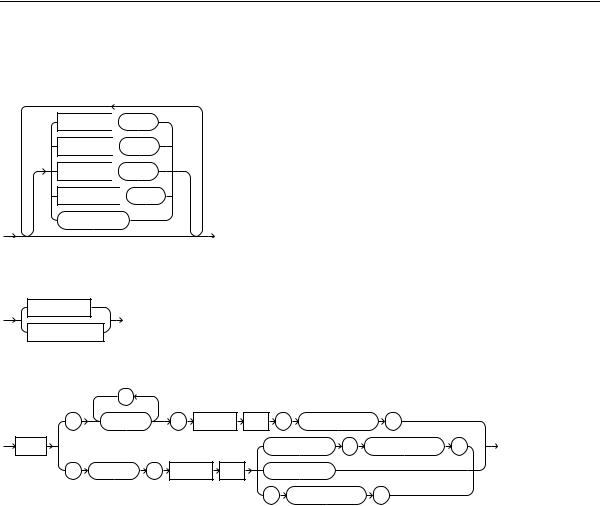
ALTER MATERIALIZED VIEW
clause::= on page 9-95, logging_clause::= on page 9-95, allocate_ extent_clause::= on page 9-96)
physical_attributes_clause::=
PCTFREE  integer
integer
PCTUSED  integer
integer
INITRANS  integer
integer
MAXTRANS  integer
integer
storage_clause
(storage_clause::= on page 7-58) data_segment_compression::=
COMPRESS
NOCOMPRESS
LOB_storage_clause::=
|
, |
|
|
|
|
|
|
|
|
|
|
|
( |
LOB_item |
|
) |
STORE |
AS |
( |
LOB_parameters |
) |
|
|||
LOB |
|
|
|
|
|
LOB_segname |
( |
LOB_parameters |
) |
|||
( |
LOB_item |
) |
STORE |
AS |
LOB_segname |
|
|
|
|
|||
|
|
|
|
|
|
( |
|
LOB_parameters |
|
) |
|
|
SQL Statements: ALTER CLUSTER to ALTER SEQUENCE 9-93
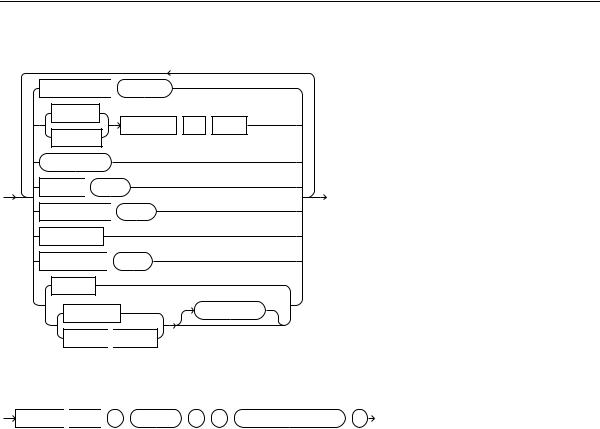
ALTER MATERIALIZED VIEW
LOB_parameters::=
TABLESPACE  tablespace
tablespace
ENABLE
STORAGE  IN
IN  ROW
ROW
DISABLE
storage_clause
CHUNK  integer
integer
PCTVERSION  integer
integer
RETENTION
FREEPOOLS  integer
integer
CACHE
NOCACHE |
logging_clause |
CACHE  READS
READS
(storage_clause::= on page 7-58, logging_clause::= on page 7-46) modify_LOB_storage_clause::=
MODIFY  LOB
LOB  (
(  LOB_item
LOB_item  )
)  (
(  modify_LOB_parameters
modify_LOB_parameters  )
)
9-94 Oracle9i SQL Reference
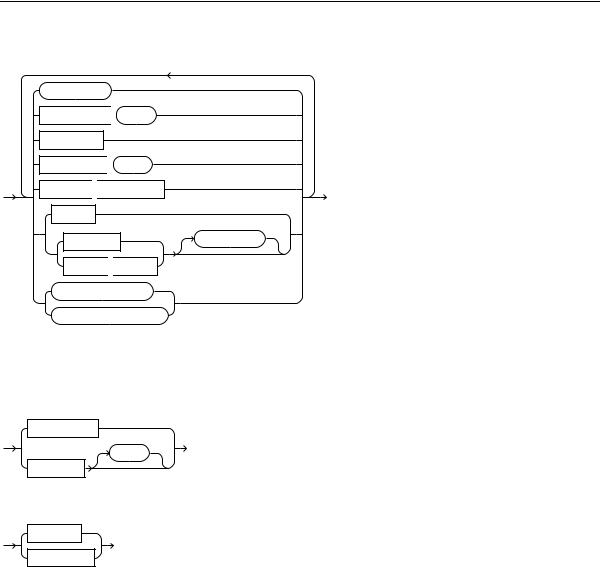
ALTER MATERIALIZED VIEW
modify_LOB_parameters::=
storage_clause
PCTVERSION  integer
integer
RETENTION
FREEPOOLS  integer
integer
REBUILD  FREEPOOLS
FREEPOOLS
CACHE
NOCACHE |
logging_clause |
CACHE  READS
READS
allocate_extent_clause
deallocate_unused_clause
(storage_clause::= on page 7-58, logging_clause::= on page 7-46, allocate_extent_clause::= on page 9-96, deallocate_unused_ clause::= on page 9-96)
parallel_clause::=
NOPARALLEL
integer
PARALLEL
logging_clause::=
LOGGING
NOLOGGING
SQL Statements: ALTER CLUSTER to ALTER SEQUENCE 9-95
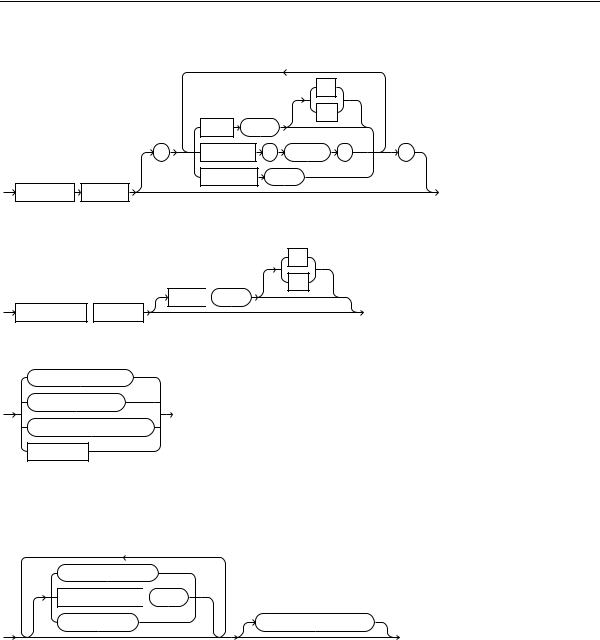
ALTER MATERIALIZED VIEW
allocate_extent_clause::=
|
|
|
|
|
K |
|
|
|
|
|
|
|
M |
|
|
|
|
SIZE |
integer |
|
|
||
|
( |
DATAFILE |
’ |
filename |
’ |
) |
|
|
|
INSTANCE |
|
integer |
|
|
|
ALLOCATE |
EXTENT |
|
|
|
|
|
|
deallocate_unused_clause::=
K
M
KEEP  integer
integer
DEALLOCATE  UNUSED
UNUSED
alter_iot_clauses::=
index_org_table_clause
alter_overflow_clause
alter_mapping_table_clauses
COALESCE
(index_org_table_clause::= on page 9-96, alter_overflow_clause::= on page 9-97, alter_mapping_table_clauses: not supported with materialized views)
index_org_table_clause::=
mapping_table_clause
PCTTHRESHOLD  integer
integer
key_compression |
index_org_overflow_clause |
(mapping_table_clause: not supported with materialized views, key_ compression: not supported with materialized views, index_org_overflow_ clause::= on page 9-97)
9-96 Oracle9i SQL Reference
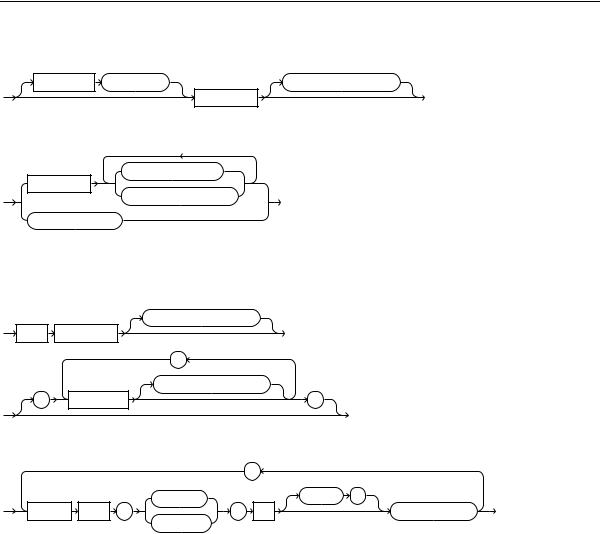
ALTER MATERIALIZED VIEW
index_org_overflow_clause::=
INCLUDING |
column_name |
segment_attributes_clause |
|
|
OVERFLOW |
alter_overflow_clause::=
allocate_extent_clause
OVERFLOW
deallocate_unused_clause
add_overflow_clause
(allocate_extent_clause::= on page 9-96, deallocate_unused_ clause::= on page 9-96)
add_overflow_clause::=
|
|
segment_attributes_clause |
ADD |
OVERFLOW |
|
|
|
, |
|
|
segment_attributes_clause |
( |
PARTITION |
) |
scoped_table_ref_constraint::=
|
|
|
|
, |
|
|
|
|
|
ref_column |
|
schema |
. |
SCOPE |
FOR |
( |
) |
IS |
|
scope_table_name |
|
|
|
ref_attribute |
|
|
|
SQL Statements: ALTER CLUSTER to ALTER SEQUENCE 9-97
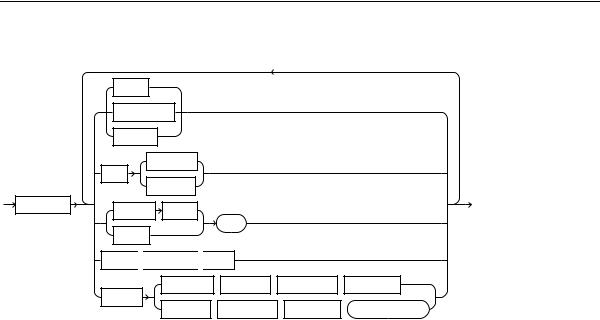
ALTER MATERIALIZED VIEW
alter_mv_refresh::=
FAST
COMPLETE
FORCE
DEMAND
ON
COMMIT
REFRESH
START WITH
date
NEXT
WITH  PRIMARY
PRIMARY  KEY
KEY
DEFAULT  MASTER
MASTER  ROLLBACK
ROLLBACK  SEGMENT
SEGMENT
USING
MASTER  ROLLBACK
ROLLBACK  SEGMENT
SEGMENT  rollback_segment
rollback_segment
Semantics
schema
Specify the schema containing the materialized view. If you omit schema, Oracle assumes the materialized view is in your own schema.
materialized_view
Specify the name of the materialized view to be altered.
physical_attributes_clause
Specify new values for the PCTFREE, PCTUSED, INITRANS, and MAXTRANS parameters (or, when used in the USING INDEX clause, for the INITRANS and MAXTRANS parameters only) and the storage characteristics for the materialized view.
See Also:
■ALTER TABLE on page 11-2 for information on the PCTFREE,
PCTUSED, INITRANS, and MAXTRANS parameters
■storage_clause on page 7-56 for information about storage characteristics
9-98 Oracle9i SQL Reference

ALTER MATERIALIZED VIEW
data_segment_compression
Use the data_segment_compression clause to instruct Oracle whether to compress data segments to reduce disk and memory use. The COMPRESS keyword enables data segment compression. The NOCOMPRESS keyword disables data segment compression.
See Also: data_segment_compression clause of CREATE TABLE on page 15-29 for more information on data segment compression
LOB_storage_clause
The LOB_storage_clause lets you specify the storage characteristics of a new LOB. LOB storage behaves for materialized views exactly as it does for tables.
See Also: the LOB_storage_clause of CREATE TABLE on page 15-36 for information on the LOB storage parameters
modify_LOB_storage_clause
The modify_LOB_storage_clause lets you modify the physical attributes of the LOB attribute lob_item or LOB object attribute. Modification of LOB storage behaves for materialized views exactly as it does for tables.
See Also: the modify_LOB_storage_clause of ALTER TABLE on page 11-57 for information on the LOB storage parameters that can be modified
alter_table_partitioning
The syntax and general functioning of the partitioning clauses for materialized views is the same as for partitioned tables.
See Also: alter_table_partitioning on page 11-60
Restrictions on Altering Table Partitions
■You cannot specify the LOB_storage_clause or modify_LOB_storage_ clause within any of the partitioning_clauses.
■If you attempt to drop, truncate, or exchange a materialized view partition, Oracle raises an error.
SQL Statements: ALTER CLUSTER to ALTER SEQUENCE 9-99

ALTER MATERIALIZED VIEW
Note: If you wish to keep the contents of the materialized view synchronized with those of the master table, Oracle Corporation recommends that you manually perform a complete refresh of all materialized views dependent on the table after dropping or truncating a table partition.
MODIFY PARTITION UNUSABLE LOCAL INDEXES Use this clause to mark
UNUSABLE all the local index partitions associated with partition.
MODIFY PARTITION REBUILD UNUSABLE LOCAL INDEXES Use this clause to rebuild the unusable local index partitions associated with partition.
parallel_clause
The parallel_clause lets you change the default degree of parallelism for the materialized view.
Note: The syntax of the parallel_clause supersedes syntax appearing in earlier releases of Oracle. Superseded syntax is still supported for backward compatibility, but may result in slightly different behavior than that documented.
NOPARALLEL Specify NOPARALLEL for serial execution. This is the default.
PARALLEL Specify PARALLEL if you want Oracle to select a degree of parallelism equal to the number of CPUs available on all participating instances times the value of the PARALLEL_THREADS_PER_CPU initialization parameter.
PARALLEL integer Specification of integer indicates the degree of parallelism, which is the number of parallel threads used in the parallel operation. Each parallel thread may use one or two parallel execution servers. Normally Oracle calculates the optimum degree of parallelism, so it is not necessary for you to specify integer.
See Also: "Notes on the parallel_clause" for CREATE TABLE on page 15-54
logging_clause
Specify or change the logging characteristics of the materialized view.
9-100 Oracle9i SQL Reference

ALTER MATERIALIZED VIEW
See Also: logging_clause on page 7-45 for a full description of this clause
allocate_extent_clause
The allocate_extent_clause lets you explicitly allocate a new extent for the materialized view.
See Also: allocate_extent_clause on page 7-2 for a full description of this clause
CACHE | NOCACHE
For data that will be accessed frequently, CACHE specifies that the blocks retrieved for this table are placed at the most recently used end of the LRU list in the buffer cache when a full table scan is performed. This attribute is useful for small lookup tables. NOCACHE specifies that the blocks are placed at the least recently used end of the LRU list.
See Also: ALTER TABLE on page 11-2 for information about specifying CACHE or NOCACHE
alter_iot_clauses
Use the alter_iot_clauses to change the characteristics of an index-organized materialized view. The keywords and parameters of the components of the alter_ iot_clauses have the same semantics as in ALTER TABLE, with the restrictions that follow.
Restrictions on Altering Index-organized Materialized Views You cannot specify the mapping_table_clause or the key_compression clause of the index_ org_table_clause.
See Also: "index_org_table_clause" of CREATE MATERIALIZED VIEW on page 14-18 for information on creating an index-organized materialized view
USING INDEX Clause
Use this clause to change the value of INITRANS, MAXTRANS, and STORAGE parameters for the index Oracle uses to maintain the materialized view’s data.
Restriction on the USING INDEX clause You cannot specify the PCTUSED or
PCTFREE parameters in this clause.
SQL Statements: ALTER CLUSTER to ALTER SEQUENCE 9-101

ALTER MATERIALIZED VIEW
MODIFY scoped_table_ref_constraint
Use the MODIFY scoped_table_ref_constraint clause to rescope a REF column or attribute to a new table.
Restrictions on Rescoping REF Columns You can rescope only one REF column or attribute in each ALTER MATERIALIZED VIEW statement, and this must be the only clause in this statement.
REBUILD Clause
Specify REBUILD to regenerate refresh operations if a type that is referenced in materialized_view has evolved.
Restriction on the REBUILD clause You cannot specify any other clause in the same ALTER MATERIALIZED VIEW statement.
alter_mv_refresh
Use the alter_mv_refresh to change the default method and mode and the default times for automatic refreshes. If the contents of a materialized view’s master tables are modified, the data in the materialized view must be updated to make the materialized view accurately reflect the data currently in its master table(s). This clause lets you schedule the times and specify the method and mode for Oracle to refresh the materialized view.
Note: This clause only sets the default refresh options. For instructions on actually implementing the refresh, refer to Oracle9i Advanced Replication and Oracle9i Data Warehousing Guide.
FAST Clause
Specify FAST for incremental refresh method, which performs the refresh according to the changes that have occurred to the master tables. The changes are stored either in the materialized view log associated with the master table (for conventional DML changes) or in the direct loader log (for direct-path INSERT operations).
For both conventional DML changes and for direct-path INSERTs, other conditions may restrict the eligibility of a materialized view for fast refresh.
9-102 Oracle9i SQL Reference

ALTER MATERIALIZED VIEW
See Also:
■Oracle9i Advanced Replication for restrictions on fast refresh in replication environments
■Oracle9i Data Warehousing Guide for restrictions on fast refresh in data warehouse environments
■"Automatic Refresh: Examples" on page 9-107
Restrictions on FAST Refresh
■When you specify FAST refresh at create time, Oracle verifies that the materialized view you are creating is eligible for fast refresh. When you change the refresh method to FAST in an ALTER MATERIALIZED VIEW statement, Oracle does not perform this verification. If the materialized view is not eligible for fast refresh, Oracle will return an error when you attempt to refresh this view.
■Materialized views are not eligible for fast refresh if the defining query contains an analytic function.
See Also: "Analytic Functions" on page 6-10
COMPLETE Clause
Specify COMPLETE for the complete refresh method, which is implemented by executing the materialized view’s defining query. If you request a complete refresh, Oracle performs a complete refresh even if a fast refresh is possible.
See Also: "Complete Refresh: Example" on page 9-108
FORCE Clause
Specify FORCE if, when a refresh occurs, you want Oracle to perform a fast refresh if one is possible or a complete refresh otherwise.
ON COMMIT Clause
Specify ON COMMIT if you want a fast refresh to occur whenever Oracle commits a transaction that operates on a master table of the materialized view.
Restriction on ON COMMIT This clause is supported only for materialized join views and single-table materialized aggregate views.
SQL Statements: ALTER CLUSTER to ALTER SEQUENCE 9-103

ALTER MATERIALIZED VIEW
See Also: Oracle9i Advanced Replication and Oracle9i Data
Warehousing Guide
ON DEMAND Clause
Specify ON DEMAND if you want the materialized view to be refreshed on demand by calling one of the three DBMS_MVIEW refresh procedures. If you omit both ON COMMIT and ON DEMAND, ON DEMAND is the default.
See Also:
■
■
Oracle9i Supplied PL/SQL Packages and Types Reference for information on these procedures
Oracle9i Data Warehousing Guide on the types of materialized views you can create by specifying REFRESH ON DEMAND
Note: If you specify ON COMMIT or ON DEMAND, you cannot also specify START WITH or NEXT.
START WITH Clause
Specify START WITH date to indicate a date for the first automatic refresh time.
NEXT Clause
Specify NEXT to indicate a date expression for calculating the interval between automatic refreshes.
Both the START WITH and NEXT values must evaluate to a time in the future. If you omit the START WITH value, Oracle determines the first automatic refresh time by evaluating the NEXT expression with respect to the creation time of the materialized view. If you specify a START WITH value but omit the NEXT value, Oracle refreshes the materialized view only once. If you omit both the START WITH and NEXT values, or if you omit the alter_mv_refresh entirely, Oracle does not automatically refresh the materialized view.
WITH PRIMARY KEY Clause
Specify WITH PRIMARY KEY to change a rowid materialized view to a primary key materialized view. Primary key materialized views allow materialized view master tables to be reorganized without affecting the materialized view’s ability to continue to fast refresh.
9-104 Oracle9i SQL Reference

ALTER MATERIALIZED VIEW
For you to specify this clause, the master table must contain an enabled primary key constraint and must have defined on it a materialized view log that logs primary key information.
See Also:
■Oracle9i Advanced Replication for detailed information about primary key materialized views and Oracle9i Database Migration Guide for information on changing rowid materialized views to primary key materialized views
■"Primary Key Materialized View: Example" on page 9-109
USING ROLLBACK SEGMENT Clause
Specify USING ROLLBACK SEGMENT to change the remote rollback segment to be used during materialized view refresh, where rollback_segment is the name of the rollback segment to be used.
See Also: Oracle9i Advanced Replication for information on changing the local materialized view rollback segment using the DBMS_REFRESH package and "Changing Materialized View Rollback Segments: Examples" on page 9-109
DEFAULT Specify DEFAULT if you want Oracle to choose the rollback segment to use. If you specify DEFAULT, you cannot specify rollback_segment.
MASTER ... rollback_segment Specify the remote rollback segment to be used at the remote master for the individual materialized view. (To change the local materialized view rollback segment, use the DBMS_REFRESH package, described in
Oracle9i Advanced Replication.)
One master rollback segment is stored for each materialized view and is validated during materialized view creation and refresh. If the materialized view is complex, the master rollback segment, if specified, is ignored.
QUERY REWRITE Clause
Use this clause to determine whether the materialized view is eligible to be used for query rewrite.
ENABLE Clause
Specify ENABLE to enable the materialized view for query rewrite.
SQL Statements: ALTER CLUSTER to ALTER SEQUENCE 9-105

ALTER MATERIALIZED VIEW
See Also: "Enabling Query Rewrite: Example" on page 9-108
Restrictions on Enabling Materialized Views
■If the materialized view is in an invalid or unusable state, it is not eligible for query rewrite in spite of the ENABLE mode.
■You cannot enable query rewrite if the materialized view was created totally or in part from a view.
■You can enable query rewrite only if all user-defined functions in the materialized view are DETERMINISTIC.
See Also: CREATE FUNCTION on page 13-52
■You can enable query rewrite only if expressions in the statement are repeatable. For example, you cannot include CURRENT_TIME or USER.
See Also: Oracle9i Data Warehousing Guide for more information on query rewrite
DISABLE Clause
Specify DISABLE if you do not want the materialized view to be eligible for use by query rewrite. (If a materialized view is in the invalid state, it is not eligible for use by query rewrite, whether or not it is disabled.) However, a disabled materialized view can be refreshed.
COMPILE
Specify COMPILE to explicitly revalidate a materialized view. If an object upon which the materialized view depends is dropped or altered, the materialized view remains accessible, but it is invalid for query rewrite. You can use this clause to explicitly revalidate the materialized view to make it eligible for query rewrite.
If the materialized view fails to revalidate, it cannot be refreshed or used for query rewrite.
See Also: "Compiling a Materialized View: Example" on page 9-109
CONSIDER FRESH
This clause lets you manage the staleness state of a materialized after changes have been made to its master tables. CONSIDER FRESH directs Oracle to consider the
9-106 Oracle9i SQL Reference

ALTER MATERIALIZED VIEW
materialized view fresh and therefore eligible for query rewrite in the TRUSTED or STALE_TOLERATED modes. Because Oracle cannot guarantee the freshness of the materialized view, query rewrite in ENFORCED mode is not supported. This clause also sets the staleness state of the materialized view to UNKNOWN. The staleness state is displayed in the STALENESS column of the ALL_MVIEWS, DBA_MVIEWS, and USER_MVIEWS data dictionary views.
Note: A materialized view is stale if changes have been made to the contents of any of its master tables. This clause directs Oracle to assume that the materialized view is fresh and that no such changes have been made. Therefore, actual updates to those tables pending refresh are purged with respect to the materialized view.
See Also: Oracle9i Data Warehousing Guide for more information on query rewrite and the implications of performing partition maintenance operations on master tables, and "CONSIDER FRESH: Example" on page 9-108
Examples
Automatic Refresh: Examples The following statement changes the default refresh method for the sales_by_month_by_state materialized view (created in "Creating Materialized Aggregate Views: Example" on page 14-28) to FAST:
ALTER MATERIALIZED VIEW sales_by_month_by_state
REFRESH FAST;
The next automatic refresh of the materialized view will be a fast refresh provided it is a simple materialized view and its master table has a materialized view log that was created before the materialized view was created or last refreshed.
Because the REFRESH clause does not specify START WITH or NEXT values, Oracle will use the refresh intervals established by the REFRESH clause when the sales_ by_month_by_state materialized view was created or last altered.
The following statement stores a new interval between automatic refreshes for the sales_by_month_by_state materialized view:
ALTER MATERIALIZED VIEW sales_by_month_by_state
REFRESH NEXT SYSDATE+7;
SQL Statements: ALTER CLUSTER to ALTER SEQUENCE 9-107

ALTER MATERIALIZED VIEW
Because the REFRESH clause does not specify a START WITH value, the next automatic refresh occurs at the time established by the START WITH and NEXT values specified when the sales_by_month_by_state materialized view was created or last altered.
At the time of the next automatic refresh, Oracle refreshes the materialized view, evaluates the NEXT expression SYSDATE+7 to determine the next automatic refresh time, and continues to refresh the materialized view automatically once a week. Because the REFRESH clause does not explicitly specify a refresh method, Oracle continues to use the refresh method specified by the REFRESH clause of the CREATE MATERIALIZED VIEW or most recent ALTER MATERIALIZED VIEW statement.
CONSIDER FRESH: Example The following statement instructs Oracle that materialized view sales_by_month_by_state should be considered fresh. This statement allows sales_by_month_by_state to be eligible for query rewrite in TRUSTED mode even after you have performed partition maintenance operations on the master tables of sales_by_month_by_state:
ALTER MATERIALIZED VIEW sales_by_month_by_state CONSIDER FRESH;
See Also: Splitting Table Partitions: Examples on page 11-93 for a partitioning maintenance example that would require this ALTER MATERIALIZED VIEW example
Complete Refresh: Example The following statement specifies a new refresh method, a new NEXT refresh time, and a new interval between automatic refreshes of the emp_data materialized view (created in "Periodic Refresh of Materialized Views: Example" on page 14-30):
ALTER MATERIALIZED VIEW emp_data
REFRESH COMPLETE
START WITH TRUNC(SYSDATE+1) + 9/24
NEXT SYSDATE+7;
The START WITH value establishes the next automatic refresh for the materialized view to be 9:00 a.m. tomorrow. At that point, Oracle performs a complete refresh of the materialized view, evaluates the NEXT expression, and subsequently refreshes the materialized view every week.
Enabling Query Rewrite: Example The following statement enables query rewrite on the materialized view mv1 and implicitly revalidates it:
9-108 Oracle9i SQL Reference

ALTER MATERIALIZED VIEW
ALTER MATERIALIZED VIEW emp_data
ENABLE QUERY REWRITE;
Changing Materialized View Rollback Segments: Examples The following statement changes the remote master rollback segment used during materialized view refresh to rbs_two:
ALTER MATERIALIZED VIEW new_employees
REFRESH USING MASTER ROLLBACK SEGMENT rbs_two;
The following statement changes the remote master rollback segment used during materialized view refresh to one chosen by Oracle:
ALTER MATERIALIZED VIEW new_employees
REFRESH USING DEFAULT MASTER ROLLBACK SEGMENT;
Primary Key Materialized View: Example The following statement changes the rowid materialized view order_data (created in "Creating Rowid Materialized Views: Example" on page 14-30) to a primary key materialized view. This example requires that you have already defined a materialized view log with a primary key on order_data.
ALTER MATERIALIZED VIEW order_data
REFRESH WITH PRIMARY KEY;
Compiling a Materialized View: Example The following statement revalidates the materialized view store_mv:
ALTER MATERIALIZED VIEW order_data COMPILE;
SQL Statements: ALTER CLUSTER to ALTER SEQUENCE 9-109
